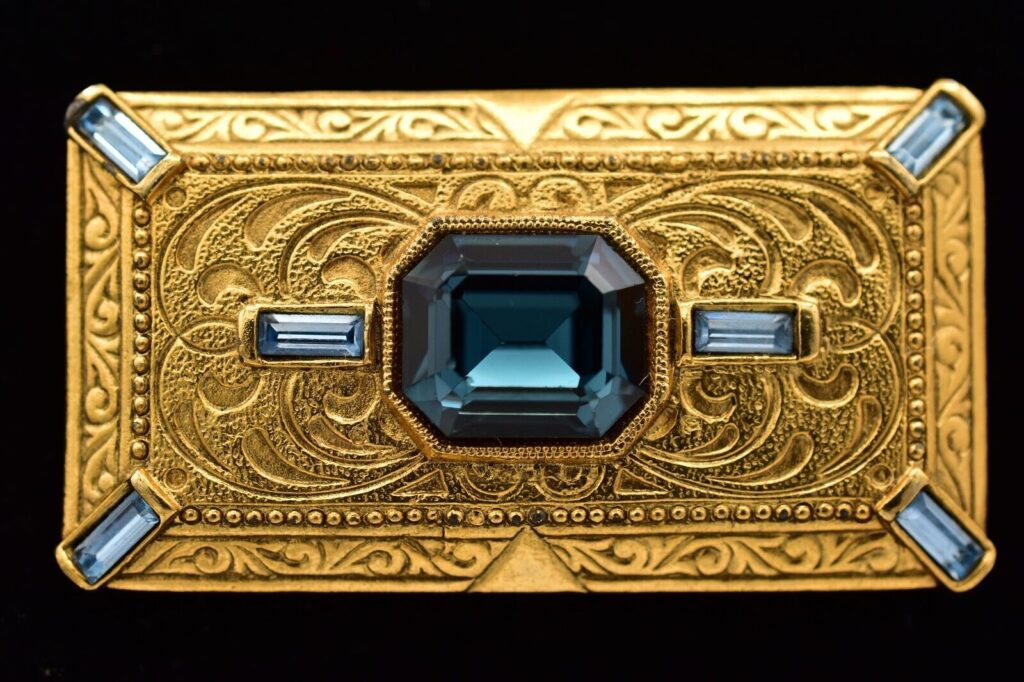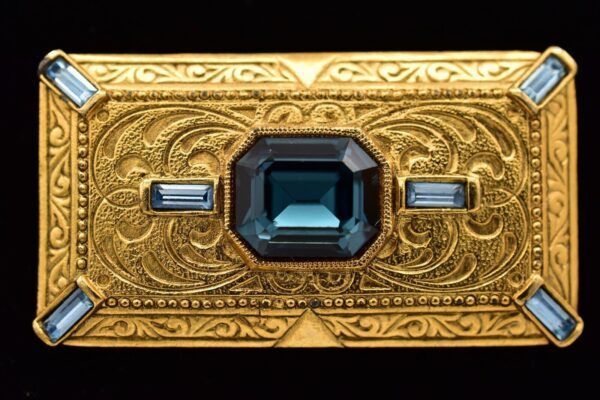#Jewelry #Buy #Leave #WorthPoint

Antique style brooch marketed by 1928 in the 1980s.
I often start my articles reminiscing about someone in the jewelry industry who’s impressed me over the years or a favorite type of jewelry to wear. On the topic of 1928 brand jewelry, well, I’ve got nothing. It’s not that I haven’t been aware of these baubles for a long time, but they weren’t really my thing. Too frilly, too feminine, or just too something that always made me look in another direction back when I was accessorizing as a young woman.
As I was contemplating writing about whether to buy this jewelry now, I took a closer look at the varied styles marketed by 1928. Many of them still aren’t my thing, but I found a few styles I wasn’t aware of that I would certainly don with the right outfit. With fashion moving back into ruffles and other frills accompanied by rich fabrics like velvet and satin, some pieces would look quite pretty. Pendant necklaces made by this brand can be great for layering, too, if you like that trend. Even so, does that mean you should buy them for resale?
The answer depends on your small business’s goals and the things you feel are worth keeping in your inventory. Before I delve into what to purchase and what to avoid, however, I’ll tell you a little more about the company that produced the products marked 1928 (and later 2028) because its history is important in the grand scheme of jewelry production in the United States.
A Brief Intro to the 1928 Brand
The 1928 brand was established in 1968 by Mel Bernie. He began with a partner crafting jewelry in a garage with very little money and little to no knowledge about jewelry making. Nevertheless, their drive was rewarded as they stuck with the task, as noted by Brenda Sue Lansdowne, author of Making It 1928: The Story of the 1928 Jewelry Company.
The California-based business, located in Burbank since the late 1970s, has always been known for offering jewelry inspired by antique and vintage styles. The company refers to these as “modern replicas” on its website and touts that its jewelry has been made in the United States since its inception. All production is done in-house, from designing and model-making to casting and finishing. That’s impressive in today’s jewelry world as more and more of the old faithful manufacturing businesses here continue closing their doors.
Over the years, other brands and collections have been added to 1928’s offerings. One is 2028, which has a more contemporary vibe, and the pieces are marked with 2028 hang tags. Others include bohemian designs in the T.R.U. collection that incorporate some semi-precious stones and materials like suede and leather with traditional metals. Then there’s the Antiquities collection with higher-than-average price points and styles reminiscent of ancient Greece, the Renaissance, and Victorian styles, some of which also have semi-precious stones. These are all currently being made by 1928, but the pieces they made and sold decades ago are now vintage, of course.
In addition to checking out Lansdowne’s book, if you want to learn more about 1928 jewelry, I recommend watching a YouTube video that offers an excellent overview of 1928’s factory processes from start to finish. This video will give you an idea about what goes into making all types of costume jewelry and why it’s a treasure to still have this type of business operating here in the United States.
1928 to Consider Buying
Looking closer at 1928 jewelry, I think some of the newer pieces selling at higher price points are worth buying. In particular, the items in the Antiquities line are worth peeking at on the company’s website. Many people who see jewelry in boutique settings will try to find the same styles secondhand at a more affordable price.
Some styles, sold for many years, are also popular with vintage buyers, including magnifying glass pendants on long chains. Old-fashioned gumball machine pins with matching necklaces that have little bead “gumballs” rolling around inside the globes are also still available on the 1928 website. People buy those secondhand as well, but be sure not to spend so much that your values would extend beyond the retail pricing of $45-60 each.
Lockets and pieces with vintage-looking charms can also catch the eye of online shoppers, so I always look for them. Using the Worthpoint Price Guide is one of the best ways to know whether you’re picking up pieces at the right price.
What to Leave Behind
As much as I admire 1928 for staying dedicated to manufacturing jewelry in the U.S., there are many pieces that I don’t bother picking up, even if they’re inexpensively priced. For example, I’ve always had difficulty selling pieces by this brand embellished with little porcelain roses, faux pearls, and plastic cameos. The tide may be turning on that a bit with the return of romantic clothing styles, but I’m still proceeding with caution in those areas.
Keeping an eye on quality is also a good idea since some 1928 jewelry is made with more detailing and heavier components than others. I also avoid pieces that look too plasticky, like some beaded necklaces. For me, the selling prices at $10-15 each don’t warrant the work my husband and I have to accomplish prepping, photographing, listing, and shipping to make a few dollars profit after all the selling fees are paid.
That said, in my book, this is very much a “your mileage may vary” brand. If you sell at flea markets or tend to put together lots of jewelry to auction on eBay, you might have better luck than I do selling piece by piece. Bottom line? Proceed with caution, but don’t completely ignore the 1928 brand.
Pamela Siegel is a freelance writer and author who has been educating collectors for more than two decades. In addition to three books on topics relating to antiques and collectibles, she frequently shares her expertise through online writing and articles for print-based publications. Pamela is also the co-founder of Costume Jewelry Collectors Int’l (CJCI) and the proprietor of Chic Antiques by Pamela.
WorthPoint—Discover. Value. Preserve.




